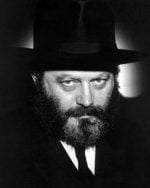Listen, O heavens, and I will speak! And let the earth hear the words of my mouth!
(Deut. 32:1)
In this Torah portion Haazinu, Moses appeals to heavens and earth as witnesses. However, a few verses later, he extorts the Jewish people:
“Ask your father, and he will tell you; your elders, and they will inform you” (Deut. 32:7)
as if to confirm the testimony of heavens and earth. Why wasn’t the testimony of heavens and earth enough? Why did their testimony need to be corroborated by “your father” and “your elders”?

The Lubavitcher Rebbe, Rabbi Menachem Mendel Schneerson, in one of his talks (see R’ Schneerson, M.M. Likute Sihot (Brooklyn, NY: Vaad L’Hafotzas Sichos, 1998) v. XIX, Devorim, pp. 188-196) discusses the Talmudic concept of two types of witnesses: clarifying witnesses and establishing witnesses (see Talmud, tr. Kiddushin, 65b). The first type of witnesses is called eidei birur, or clarifying witnesses. These witnesses do not consummate the transaction that they witness, but they clarify the transaction if its terms are later disputed. Witnesses to a business transaction are clarifying witnesses. To be sure, a business transaction takes effect regardless of whether witnesses are present.
The second type of witnesses is called eidei kiyum, or establishing witnesses. These witnesses are an integral part of the transaction that they view, and in their absence, the transaction has no effect. Witnesses to the ceremony of Jewish betrothal (Kidushin) are establishing witnesses, and their testimony establishes the marriage in Jewish law (see ibid.). Without their presence, the marriage does not take effect. Establishing witnesses can also be called upon to clarify the transaction at some later point, but that is not their primary function.

The Rebbe draws the parallel with two interpretations in the Zohar (III, 86), of the verse:
“You are my witnesses, says G‑d.” (Isaiah 43:10)
One interpretation is (the simple interpretation of the verse) that it refers to the Jewish people. The second interpretation is that the verse alludes to the sky and earth as witnesses, as another verse states:
“I call heaven and earth as witnesses.” (Deut., 30:19)
According to the Rebbe, the latter interpretation suggests that heaven and earth are clarifying witnesses, whereas the former interpretation, referring to the Jewish People, considers them establishing witnesses, whose testimony establishes the act of creation. The parallel between the Talmudic “establishing witness” and Wheeler’s “participating observer” is remarkable.
This discussion sheds light on the question of the interplay between science and faith. Both play important but different roles as respectively clarifying and establishing testimonies to the creation. Recall that in Talmudic law the clarifying witnesses are subjected to interrogation to clarify their fitness as witnessed and the veracity of their testimony. Heaven and earth, which are called “witnesses” by Moses and which, according to the Rebbe, are clarifying witness, need to be thoroughly examined. This is the role of science which seeks to clarify the nature and the laws of the creation by probing and examining heaven and earth, figuratively speaking. Once the clarifying witnesses are examined they can testify. This will happen, according to the Jewish tradition, in the Messianic era when heaven and earth will offer their testimony of the creation and instead of concealing G‑dliness they will bespeak it. The first human observers, Adam and Eve, on the other hand, established the very existence of the world as the establishing witnesses or, in the language of quantum physics, as participating observers, the moment that they ‘witnessed’ its existence.
Jewish people continue this process today by declaring each Friday night on the eve of Shabbat a testimony to the creation of the world (see prayer Vaihulu HaShamaym… in the Liturgy for Kabalat Shabbat). Chasidic philosophy maintains that the world is recreated by G‑d every moment (See Tanya, Shaar Yihud VeHaEmuna). Therefore, just as at the time of Adam and Eve, there is a continuous need for establishing witnesses to reaffirm and establish the act of creation. This role is played today by Jewish people who are the quintessential participating observers in the language of quantum mechanics.
Ultimately, science and faith do not contradict each other but play a complementary role of respectfully clarifying and establishing witnesses to the creation. As Niels Bohr put it, contraria sunt complimenta—the opposites are complementary.